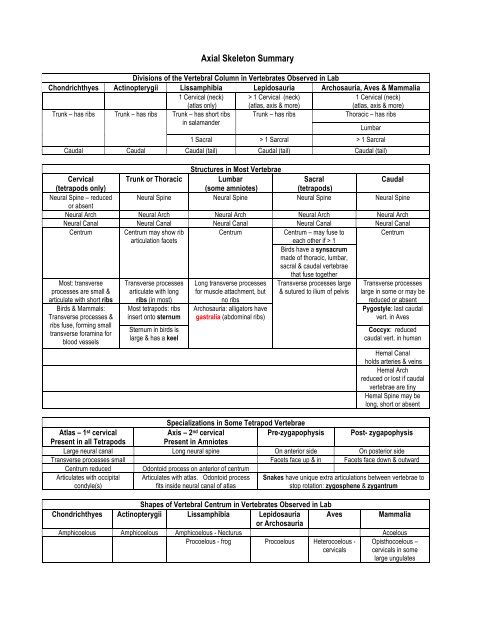Create successful ePaper yourself
Turn your PDF publications into a flip-book with our unique Google optimized e-Paper software.
Axial Skeleton Summary<br />
Divisions of the Vertebral Column in Vertebrates Observed in Lab<br />
Chondrichthyes Actinopterygii Lissamphibia Lepidosauria Archosauria, Aves & Mammalia<br />
1 Cervical (neck)<br />
(atlas only)<br />
> 1 Cervical (neck)<br />
(atlas, axis & more)<br />
1 Cervical (neck)<br />
(atlas, axis & more)<br />
Trunk – has ribs Trunk – has ribs Trunk – has short ribs<br />
in salamander<br />
Trunk – has ribs<br />
Thoracic – has ribs<br />
Lumbar<br />
1 Sacral > 1 Sarcral > 1 Sarcral<br />
Caudal Caudal Caudal (tail) Caudal (tail) Caudal (tail)<br />
Structures in Most Vertebrae<br />
Cervical Trunk or Thoracic Lumbar<br />
Sacral<br />
Caudal<br />
(tetrapods only)<br />
(some amniotes)<br />
(tetrapods)<br />
Neural Spine – reduced Neural Spine Neural Spine Neural Spine Neural Spine<br />
or absent<br />
Neural Arch Neural Arch Neural Arch Neural Arch Neural Arch<br />
Neural Canal Neural Canal Neural Canal Neural Canal Neural Canal<br />
Centrum Centrum may show rib<br />
Centrum<br />
Centrum – may fuse to<br />
Centrum<br />
articulation facets<br />
each other if > 1<br />
Birds have a synsacrum<br />
made of thoracic, lumbar,<br />
sacral & caudal vertebrae<br />
that fuse together<br />
Most: transverse<br />
processes are small &<br />
articulate with short ribs<br />
Transverse processes<br />
articulate with long<br />
ribs (in most)<br />
Long transverse processes<br />
for muscle attachment, but<br />
no ribs<br />
Transverse processes large<br />
& sutured to ilium of pelvis<br />
Transverse processes<br />
large in some or may be<br />
reduced or absent<br />
Birds & Mammals:<br />
Transverse processes &<br />
ribs fuse, forming small<br />
transverse foramina for<br />
blood vessels<br />
Most tetrapods: ribs<br />
insert onto sternum<br />
Sternum in birds is<br />
large & has a keel<br />
Archosauria: alligators have<br />
gastralia (abdominal ribs)<br />
Pygostyle: last caudal<br />
vert. in Aves<br />
Coccyx: reduced<br />
caudal vert. in human<br />
Hemal Canal<br />
holds arteries & veins<br />
Hemal Arch<br />
reduced or lost if caudal<br />
vertebrae are tiny<br />
Hemal Spine may be<br />
long, short or absent<br />
Specializations in Some Tetrapod Vertebrae<br />
Atlas – 1 st cervical<br />
Axis – 2 nd cervical<br />
Pre-zygapophysis Post- zygapophysis<br />
Present in all Tetrapods<br />
Present in Amniotes<br />
Large neural canal Long neural spine On anterior side On posterior side<br />
Transverse processes small Facets face up & in Facets face down & outward<br />
Centrum reduced Odontoid process on anterior of centrum<br />
Articulates with occipital<br />
condyle(s)<br />
Articulates with atlas. Odontoid process<br />
fits inside neural canal of atlas<br />
Snakes have unique extra articulations between vertebrae to<br />
stop rotation: zygosphene & zygantrum<br />
Shapes of Vertebral Centrum in Vertebrates Observed in Lab<br />
Chondrichthyes Actinopterygii Lissamphibia Lepidosauria Aves<br />
Mammalia<br />
or Archosauria<br />
Amphicoelous Amphicoelous Amphicoelous - Necturus Acoelous<br />
Procoelous - frog Procoelous Heterocoelous -<br />
cervicals<br />
Opisthocoelous –<br />
cervicals in some<br />
large ungulates
















